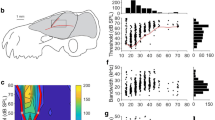Summary
The tonotopic organization and spatial sensitivity of 217 inferior collicular (IC) neurons of Eptesicus fuscus were studied under free field stimulation conditions. Acoustic stimuli were delivered from a loudspeaker placed 21 cm ahead of the bat to determine the best frequency (BF) and minimum threshold (MT) of isolated IC neurons. A BF stimulus was then delivered as the loudspeaker was moved horizontally across the frontal auditory space of the bat to locate the best azimuthal angle (BAZ) at which the neuron had its lowest MT. The stimulus was then raised 3 dB above the lowest MT to determine the horizontal extent of the auditory space within which a sound could elicit responses from the neuron. This was done by moving the loudspeaker laterally at every 5° or 10° until the neuron failed to respond. These measurements also allowed us to redetermine the BAZ at which the neuron fired maximal number of impulses. Electrodes were placed evenly across the whole IC surface and IC neurons were sampled as many as possible within each electrode penetration. Tonotopic organization and spatial sensitivity were examined among all 217 IC neurons as a whole as well as among IC neurons sequentially sampled within individual electrode penetrations. The whole population of 217 IC neurons is organized tonotopically along the dorsoventral axis of the IC. Thus, low frequency neurons are mostly located dorsally and high frequency neurons ventrally with median frequency neurons intervening in between. The BAZ of these 217 IC neurons tend to shift from lateral to medial portions of the contralateral frontal auditory space with increasing BF. Thus, the auditory space appears to have an orderly representation along the tonotopic axis of the IC. The lateral space is represented dorsally and the medial space ventrally. Nevertheless, tonotopic organization and spatial sensitivitty of sequentially isolated IC neurons within each electrode penetration may vary with the point of electrode penetration. This variation may be explained on the basis of the arrangement and thickness of each frequency lamina within the IC.
Similar content being viewed by others
References
Fuzessery ZM, Pollak GD (1985) Determinants of sound location selectivity in bat inferior colliculus: a combined dichotic and free-field stimulation study. J Neurophysiol 54: 757–781
Griffin DR (1958) Listening in the dark. Yale University Press, New Haven, Connecticut (Reprinted by Dover Publications, New York, 1974)
Grinnell AD (1963) The neurophysiology of audition in bats: directional localization and binaural interaction. J Physiol (Lond) 167: 97–113
Grinnell AD, Grinnell VS (1965) Neural correlates of vertical localization by echolocating bats. J Physiol (Lond) 181: 830–851
Jen PH-S, Chen DM (1988) Directionality of sound pressure transformation at the pinna of echolocating bats. Hearing Res 34: 101–118
Jen PH-S, Kamada T (1982) Analysis of orientation signals emitted by the CF-FM bat Pteronotus p. parnellii and the FM bat Eptesicus fuscus during avoidance of moving and stationary obstacles. J Comp Physiol 148: 389–398
Jen PH-S, Schlegel PA (1982) Auditory physiological properties of the neurons in the inferior colliculus of the big brown bat, Eptesicus fuscus. J Comp Physiol 147: 351–363
Jen PH-S, Sun XD (1984) Pinna orientation determines the maximal directional sensitivity of bat auditory neurons. Brain Res 301: 157–161
Jen PH-S, Sun XD, Chen DM, Teng HB (1987) Auditory space representation in the inferior colliculus of the FM bat, Eptesicus fuscus. Brain Res 419: 7–18
Jen PH-S, Sun XD, Lin PJ-J (1989) Frequency and space representation in the primary auditory cortex of the FM bat, Eptesicus fuscus. J Comp Physiol 165: 1–14
Makous JC, O'Neill WE (1986) Directional sensitivity of the auditory midbrain in the mustached bat to free-field tones. Hearing Res 24: 73–88
Neuweiler G (1970) Neurophysiologische Untersuchungen zum Echoortungssystem der Groβen Hufeisennase Rhinolophus ferrumequinum Z V Physiol 67: 273–306
Pettigrew A, Chung SH, Anson M (1978) Neurophysiological basis of directional hearing in amphibia. Nature 272: 138–142
Pettigrew A, Anson M, Chung SH (1981) Hearing in the frogs: a neurophysiological study of the auditory response in the midbrain. Proc R Soc Lond on Ser B 212: 433–457
Schlegel PA (1977) Directional coding by binaural brainstem units of CF-FM bat, Rhinolophus ferrumequinum. J Comp Physiol 118: 327–352
Schlegel PA, Jen PH-S, Singh S (1988) Auditory spatial sensitivity of inferior collicular neurons of echolocating bats. Brain Res 456: 127–138
Schweizer H (1980) The connections of the inferior colliculus and the organization of the brainstem auditory system in the greater horseshoe bat Rhinolophus ferrumequinum. J Comp Neurol 20: 25–49
Shimozawa T, Suga N, Hendler P, Schuetze S (1974) Directional sensitivity of echolocation systems in bats producing frequency-modulated signals. J Exp Biol 60: 53–59
Simmons JA, Fenton MB, O'Farrell MJ (1979) Echolocation and pursuit of prey by bats. Science 203: 16–21
Shimozawa T, Sun XD, Jen PH-S (1984) Auditory space representation in the superior colliculus of the big brown bat, Eptesicus fuscus. Brain Res 311: 289–296
Suga N (1964) Single unit activity in cochlear nucleus and inferior colliculus of echolocating bats. J Physiol (Lond) 172: 449–474
Suga N, Schlegel PA (1972) Neural attenuation of responses to emitted sounds in echolocating bats. Science 177: 82–84
Sun XD, Jen PH-S (1987) Pinna position affects the auditory space representation in the inferior colliculus of the FM bat, Eptesicus fuscus. Hearing Res 27: 207–219
Zook JM, Casseday JH (1982) Origin of ascending projections of inferior colliculus in the mustache bat, Pteronotus parnellii. J Comp Neurol 207: 14–28
Author information
Authors and Affiliations
Rights and permissions
About this article
Cite this article
Poon, P.W.F., Sun, X., Kamada, T. et al. Frequency and space representation in the inferior colliculus of the FM bat, Eptesicus fuscus . Exp Brain Res 79, 83–91 (1990). https://doi.org/10.1007/BF00228875
Received:
Accepted:
Issue Date:
DOI: https://doi.org/10.1007/BF00228875




